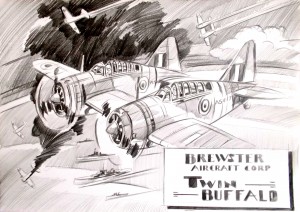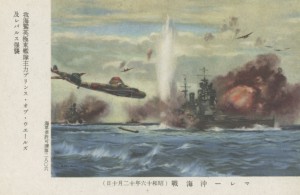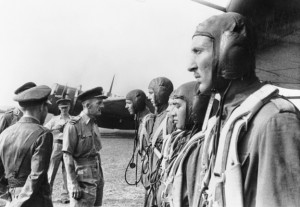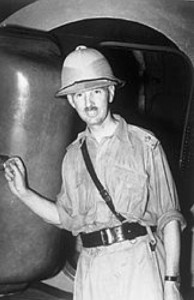Brewster Aircraft Corporation Twin Buffalo
 In mid 1941, Units of no 22 squadron RAAF based at Sembawang became acutely aware of the need to upgrade and improve the offensive capability of their frontline fighter the F2B Brewster, then recently pressed into service as a consequence of the likelihood of Japanese expansionist aggression.
In mid 1941, Units of no 22 squadron RAAF based at Sembawang became acutely aware of the need to upgrade and improve the offensive capability of their frontline fighter the F2B Brewster, then recently pressed into service as a consequence of the likelihood of Japanese expansionist aggression.
The story of the Brewster is a complex one. Its performance its inadequacies and numerous technical hitches contributed to flagging morale among aircrew. By the time General Wavell inspected the defences of Singapore the situation had become critical. Several submissions were made to the Brewster Corporation requesting advice. According to their engineers and citations; ‘the aircraft was superb both acrobatically and performed well without guns, radio, armour and fuel tanks’. However when loaded had a tendency to perform, in the words of the chief pilot, Flt. Lieut. Arthur Buggins, ‘like a slug’.
Nicknamed ‘the Flying Beer Barrel’ due to its portly shape the Brewster seemed doomed in anticipation of the oncoming Japanese onslaught. Outgunned, outmaneuvered, out-paced and outclassed by the emergence of the AM62 Zero.
Distressed by the fatalism shown by the Australian, British and New Zealand pilots stationed at Sembawang, the chief artificer, Aircraftsman Walter Widget considered adapting the basic airframe for improved performance. His twin brother Cecil Widget an experienced pilot in his own right assisted in the development of what was then referred to as a “joint strike fighter”, and in actual fact it was thus joined. By incorporating a centre wing section the Brewster’s were literally bolted together. They then increased both the capacity of the engine with additional boost and upgraded the machine guns and fuel storage to develop a truly versatile attack interceptor with considerable agility and speed at both low and high level.
An initial display to assembled dignitaries on December 7 1941 was impressive with the twin Brewster Buffalo easily outperforming single Brewster’s in climb, manouverability and accuracy, directing a quadruple stream of 50 calibre fire from wing mounted guns and four nose mounted .303 Brownings. So impressed were the air staff and army officers that an immediate conversion was ordered with great promise, just as the first wave of Japanese bombers began to soften up the Singapore defences. The first two aircraft, nicknamed ; Double Trouble 1 & 2’ were instructed to investigate the progress of the capital ships, Force Z, HMS. Prince of Wales and Repulse and their escorts of RN and RAN destroyers off Khota Baru.

Glorious depiction of Force Z being ‘zeroed in’ on. Note foreground depiction of Betty Bomber releasing torpedo. Inscription on the side reads, trans: ‘End of Empire’.
The twin Brewsters’ were able to provide effective cover, though to improve capability, radio equipment and armour had been removed. This was to have tragic consequences. After an extended period and low on fuel they were forced to return to base, this left the ships without air support at a critical time. Unbeknown to the pilots at the time, (also twins) the hybridizing of the Brewsters’ had an instantaneous and catastrophic effect upon the compass, reversing the polarity of the instrument as a result of interference from the double magnetos and increased electromagnetic stimulus. Catastrophically, rather than returning to Singapore, the aircraft flew on towards Saigon in the opposite direction where they were attacked by a squadron of Oscars. Defending themselves the Twin Buffalos, engaged the enemy and proved their agility and offensive capabilities by clearing the skies. Unfortunately winning several Oscars was not enough. Running desperately low on fuel the Brewsters’ crashed in to the sea and were not heard of again.

Air Vice Marshall Pulford questioning pilots of the Royal Dutch East Indies Air Force, ( MK-KNIL) on their claims for double pay incurred whilst flying double Brewsters. Note Twin Brewster in background.
Tragically the capital ships were later sunk and Air Vice Marshall Pulford, halted the launch of a complete squadron of twin Brewsters’ due partly to conflicting reports of their efficacy and to save precious resources. He was also embroiled in a protracted dispute with Dutch authorities over the cost of converting single Brewster’s to twin configuration. Sadly officials of the Royal Netherlands East Indies Army, (Militaire Luchtvaart van het Koninklink Nerderlands Indisch Ledger, ML-KNIL), wanted to pay for only one singular twin aircraft. To add insult to injury the Dutch pilots also demanded double pay for flying double aircraft. This protracted and heated payments dispute, infamously referred to as the “the Double-Dutchie” or the “Flying Dutch Oven” affair involved claim and counter claim which persisted right up to the fall of Singapore and Java. The dispute was only settled post war when the British Government agreed to pay for costs associated with training, as the Dutch persevered with twin pilots and claimed additional costs for training not specified in joint defence agreements. The Dutch government also claimed additional costs for servicing, spark plugs, magneto wear, and airframe shrinkage due to the tropical heat. Air Vice Marshall Pulford famously quoted Charles the Second, remarking, ‘In matters of business defer to the Dutch for giving too little and asking too much’. This did nothing to improve relations.
The remaining Brewsters were no match for the Zeroes, and none survived…recently an oceanographic exploration vessel located the original twin Brewsters’ in shallow water, where they are currently being restored and a new prototype developed as an alternative joint strike fighter for the RAAF, just in case the deal on the current ones falls through.
Brewster Twin Buffalo Specifications
Propulsion: Twin Pratt and Whitney Cyclone piston radial
Armament: 4 x .50 cal machine guns. 4 x .303 calibre Browning
4 x 250 lb bombs
Speed: 335 mph @ 15000 feet, 280 mph cruising
Range: 1200 miles
Weight: 4500 lbs
Operators: RAAF, RAF, RNZAF, ML-KNIL

